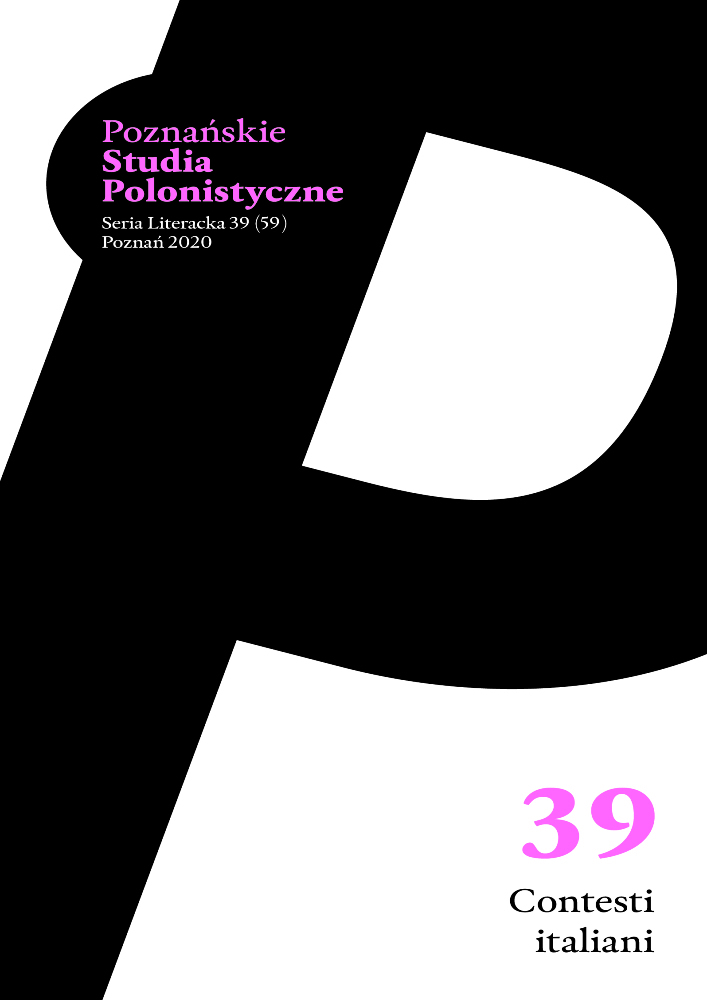Abstract
The article aims to analyse the theme of the Cossacks and the haidamaky, which was very present in the works of the great Ukrainian romantics, starting with Taras Shevchenko and Pantelejmon Kulish. It also became the object of poetic elaboration by various Polish poets including Juliusz Słowacki, and the lesser-known, but still interesting, Seweryn Goszczyński and Bohdan Zaleski. They became part of the so-called “Ukrainian school” of Polish Romanticism. In Poland, however, the poets did not interpret in a univocal way neither the historical role of the Sich of the Zaporozhye nor that of the haidamaky who sometimes appear as defenders of the faith and fighters for the independence of Ukraine, while in others they simply come into view as rebels and brigands, cruel and ruthless, who received for their
actions the cruellest punishments. The author compares Haydamaky (Haidamaky, 1841) by Shevchenko and Zamek kaniowski (Kaniów Castle, 1828) byGoszczyński, because they describe the same story from 1768, the so-called Massacre of Humań, i.e. Koliyivshchyna, but with two different visions.
References
AA.VV. (1995), Słownik języka polskiego, Wydawnictwo Naukowe PWN, Warszawa [abbr. SJP].
AA.VV. (2005), Velykyj tlumačnyj slovnyk sučasnoji ukrajins’koji movy, Irpin: Perun, Kyjiv [abbr. VTSSUM].
Barber Richard (2001), Cavalieri del Medioevo, Piemme, Monferrato.
Brückner Aleksander (1939), Encyklopedia staropolska, vol. 1, Trzaska, Evert i Michalski, Warszawa.
Goszczyński Seweryn (1906), Zamek kaniowski: powieść, Feliks West, Brody.
Graciotti Sante (1998a), Il Rinascimento nei paesi slavi, “Europa Orientalis”, n. 7, pp. 215-258.
Graciotti Sante (1998b), Le due Slavie, “Ricerche slavistiche”, n. XII, pp. 5-86.
Kitowicz Jędrzej (1855), Opis obyczajów za panowania Augusta III, vol. 2, Nakładem Bolesława Maurycego Wolffa, Petersburg, Mohylev.
Mirčuk Petro (1973), Kolijivščyna. Hajdamacke povstannja 1768 r., Naukove Tovarystvo Tarasa Ševčenka, New York.
Pachlovska Oxana (1988), Civiltà letteraria ucraina, Carocci Editore, Roma.
Rawita-Gawroński Franciszek (1899), Historya ruchów hajdamackich w XVIII wieku, Drukarnia Ludowa, Lwów.
Ševčenko Taras (1935), Hajdamaky: poema, Ukrajinska Akademija Nauk, Kyjiv.
Sokyrska Władylena, Srogosz Tadeusz (2017), Hajdamacy i koliszczyzna w historiografii polskiej i ukraińskiej. Polsko-ukraiński dwugłos, “Przegląd Nauk Historycznych”, n. 2, XVI, pp. 8-9.
Sowiński Leonard (1861), Tarasa Szewczenko studium przez Leonarda Sowińskiego z dołączeniem przekładu Hajdamaków, Nakładem Michała Gałkowskiego, Wilno.
Srogosz Tadeusz (2017), Humańska rzeź, humańska tragedia czy humańskie zwycięstwo, “Istoryčnyj archiv. Naukovi studiji”, n. 14, pp. 134-139.
Woldan Alois (2015), Gli Hajdamaky di Taras Ševčenko. Il contesto letterario, “Studi Slavistici”, n. XII, pp. 279-294.
Żmudzki Paweł (2009), Władca i wojownicy. Narracje o wodzach, drużynie i wojsku w najdawniejszej historiografii Polski i Rusi, WUW, Wrocław.
License
Authors
Authors of texts accepted for publication in „Poznańskie Studia Polonistyczne. Seria Literacka” are required to complete, sign and return to the editor's office the Agreement for granting a royalty-free license to works with a commitment to grant a CC sub-license.
Under the agreement, the authors of texts published in „Poznańskie Studia Polonistyczne. Seria Literacka” grant the Adam Mickiewicz University in Poznań a non-exclusive, royalty-free license and authorize the use of Attribution-NoDerivatives 4.0 International (CC BY-ND 4.0)Creative Commons sub-license.
The authors retain the right to continue the free disposal of the work.
Users
Interested Internet users are entitled to use works published in „Poznańskie Studia Polonistyczne. Seria Literacka” since 2016, for non-commercial purposes only, under the following conditions:
- attribution - obligation to provide, together with the distributed work, information about the authorship, title, source (link to the original work, DOI) and the license itself.
- no derivatives - the work must be preserved in its original form, without the author's consent it is not possible to distribute the modified work, such as translations, publications, etc.
Copyrights are reserved for all texts published before 2016.
Miscellaneous
Adam Mickiewicz University in Poznań retains the right to magazines as a whole (layout, graphic form, title, cover design, logo etc.).
